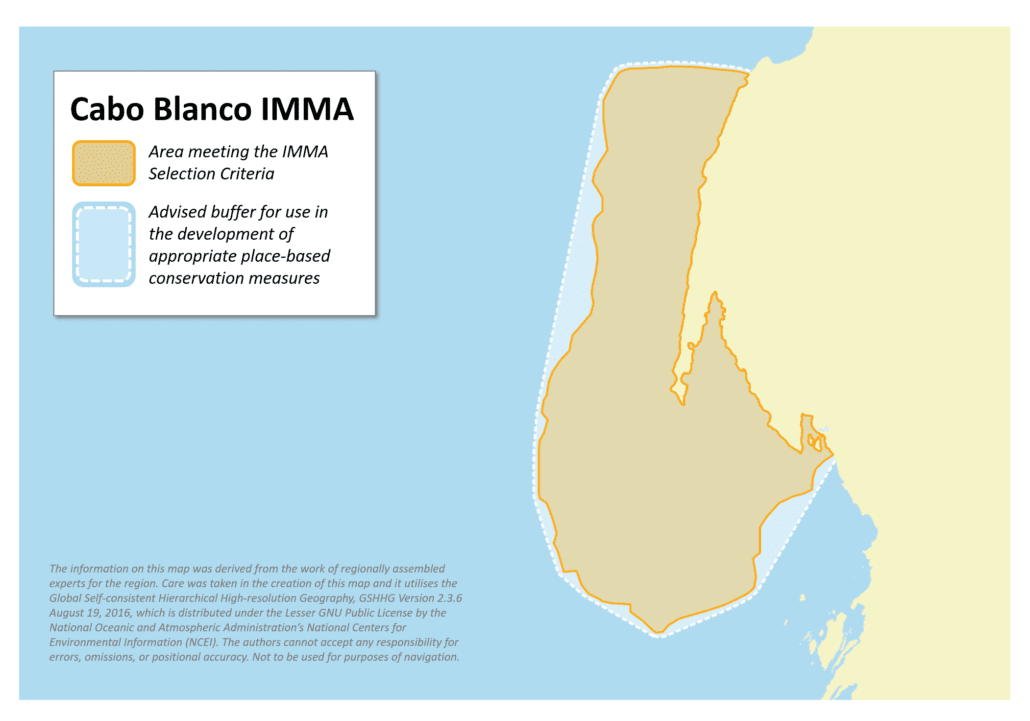Cabo Blanco IMMA
Size in Square Kilometres
19 333 km2
Qualifying Species and Criteria
Mediterranean Monk Seal – Monachus monachus
Criterion A; B (2); C (1)
Download fact sheet
Summary
One of the largest Mediterranean monk seal (Monachus monachus) populations that still survive in the world is located in the area of Cabo Blanco. The area comprises the coast of the Cabo Blanco peninsula and Guerguerat region, between both Mauritania and Morocco, from Cabo Barbas to Cabo Blanco, as well as the surrounding waters up to 25 nm offshore. The three caves currently used by the seals for breeding and hauling out are located in 1 km of coast of the Cabo Blanco peninsula, inside a marine and coastal participative reserve named “Costa de las Focas”. The marine area is also currently used by monk seals for other activities such as foraging. The IMMA contains several Special Areas of Conservation for monk seals (SACMS) designated under the Action Plan for the Recovery of the Mediterranean monk seal in the Eastern Atlantic (CMS/UNEP).
Description of Qualifying Criteria
Criterion A – Species or Population Vulnerability
The Mediterranean monk seal (Monachus monachus) is classified as an Endangered Species on the IUCN Red List. The IMMA contains some of the most important habitat for its survival and future recovery, since it contains nearly half the global population of the species, as well as the entirety of the foraging and breeding habitat of the local occurring population.
Criterion B: Distribution and Abundance
Sub-criterion B2: Aggregations
The area proposed supports the whole known foraging and breeding habitat of monk seal population inhabiting in this region. It is estimated that in 2018 more than 350 monk seals were located in area (CBD-Habitat, 2018), representing one of the single largest aggregations of the species. In particular the Cabo Blanco colony uses the three most suitable caves for their reproduction, further aggregating these animals into dense areas.
Criterion C: Key Life Cycle Activities
Sub-criterion C1: Reproductive Areas
Cliffy areas hold marine caves of different suitability to be used by seals. The Cabo Blanco monk seal colony use the three most suitable caves along the whole coast from Cabo Barbas to Cabo Blanco, located in the west coast of the Cabo Blanco peninsula. Some other cliffy areas are used by monk seal individuals, mostly adult males, to defend aquatic territories and to haul out in some beaches below the cliffs. The marine area is characterized by the permanent presence of an upwelling, and its high primary production. It is considered as one of the most productive fishing grounds of the world. All the current reproductive areas, as well as potential new ones are included in the IMMA. The IMMA comprises the only 3 caves used by the seals for breeding, as well as the aquatic territories defended by adult males with possibly reproductive objectives. In addition all foraging by the different age categories of the resident monk seal population is conducted with the IMMA thereby further enhancing the importance of the area to the pupping and weaning of young monk seals.
Supporting Information
Fernández de Larrinoa, P., Cedenilla, M.A., Gonzalez, L.M. and Aparicio, F. 2009. Satellite tracking of wild Mediterranean monk seals: a non-invasive innovative tool. in: Workshop “Who are our seals? Moving towards a standardized population estimate approach for Monachus monachus”, 23rd Annual Conference of the European Cetacean Society, Istanbul, Turkey. 28 February, 2009.
Fernández de Larrinoa, P., M’Bareck, H., Haye, M., M’Bareck, A., Muñoz, M., Cedenilla, M., González, L.M. and Aparicio, F. 2017. Spatial overlapping of industrial fishing activities with Mediterranean monk seal marine habitat use at Cabo Blanco Peninsula (Mauritania-Morocco). 31st Conference of the European Cetacean Society. Middelfart. Denmark. 1st-3rd May 2017.
Fernández de Larrinoa P., Aparicio F., Muñoz M., M´Bareck A., Haya M., Cedenilla M.A., Martínez C. and M´Bareck H. 2016. Mediterranean monk seal distribution in the Sahara coast (Mauritania/Morocco). 2016. Oral presentation at the 30th Conference of the European Cetacean Society. Madeira. Portugal. 14th-16th March 2016.
Forcada, J., Hammond, P.S. and Aguilar, A. 1999. Status of the Mediterranean monk seal Monachus monachus in the western Sahara and the implications. Marine Ecology-progress Series – Marine Ecology Progress Series. 188. 249-261. 10.3354/meps188249.
González, L.M., Fernández de Larrinoa, P., Mas, J., M’Barek, H., Cedenilla, M. and Moumni, A., 2006. Action plan for the recovery of the Mediterranean monk seal in the eastern Atlantic. Naturaleza y Parques Nacionales, Series Especies Amenazadas. Servicio de Publicaciones del Ministerio de Medio Ambiente, Madrid, Spain.
González, L. M. and Fernández de Larrinoa, P., 2012. Mediterranean monk seal Monachus monachus distribution and fisheries interactions in the Atlantic Sahara during the second half of the 20th century. Mammalia 77,41–49.
González, L.M., 2015. Prehistoric and historic distributions of the critically endangered Mediterranean monk seal (Monachus monachus) in the eastern Atlantic. Marine Mammal Science 31, 1168-1192.
Karamanlidis, A. and Dendrinos, P., 2015. Monachus monachus. The IUCN Red List of Threatened Species 2015, http://dx.doi.org/10.2305/IUCN.UK.2015-4.RLTS.T13653A45227543.en. Downloaded on 19 August 2016.
Martínez-Jaúregui, M., Tavecchia, G., Cedenilla, M.A., Coulson, T., Fernández de Larrinoa, P., Muñoz, M. and González, L.M. 2012. Population resilience of the Mediterranean monk seal (Monachus monachus) at Cabo Blanco peninsula. Marine Ecology Progress Series 461, 273–281.
Muñoz, M., Haya, M., MBareck, A., Aparicio, F., Cedenilla, M.A., MBareck, H. and Fernández de Larrinoa, P. 2016. Observatory of the Mediterranean monk seal population of the Cabo Blanco peninsula (Mauritania/Morocco). 2016. An important conservation tool. Oral presentation at the 30th Conference of the European Cetacean Society. Madeira. Portugal. 14th-16th March 2016.


